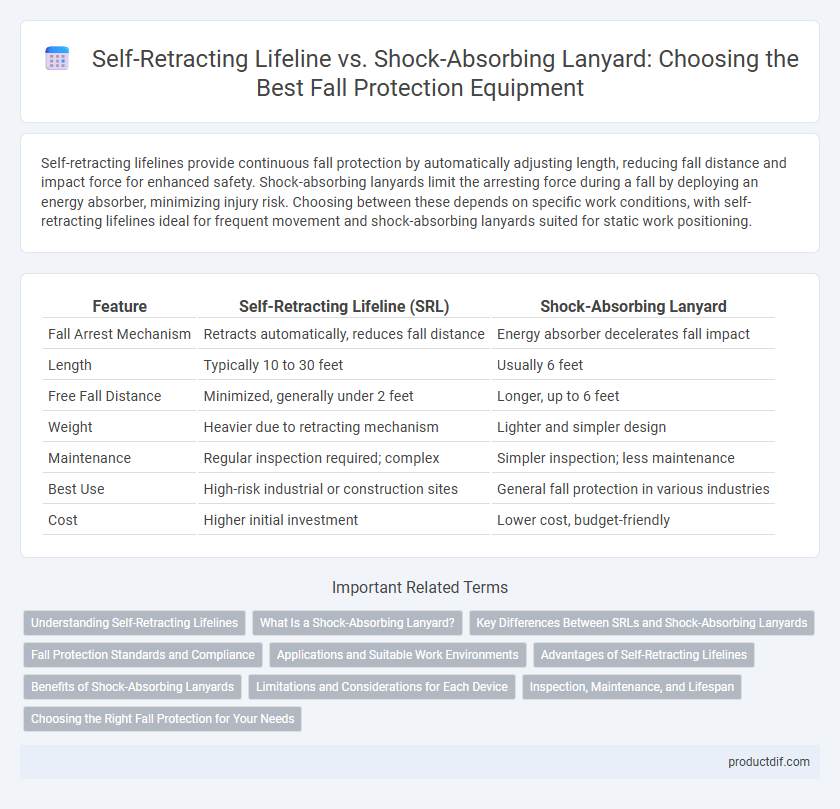Self-retracting lifelines provide continuous fall protection by automatically adjusting length, reducing fall distance and impact force for enhanced safety. Shock-absorbing lanyards limit the arresting force during a fall by deploying an energy absorber, minimizing injury risk. Choosing between these depends on specific work conditions, with self-retracting lifelines ideal for frequent movement and shock-absorbing lanyards suited for static work positioning.
Table of Comparison
| Feature | Self-Retracting Lifeline (SRL) | Shock-Absorbing Lanyard |
|---|---|---|
| Fall Arrest Mechanism | Retracts automatically, reduces fall distance | Energy absorber decelerates fall impact |
| Length | Typically 10 to 30 feet | Usually 6 feet |
| Free Fall Distance | Minimized, generally under 2 feet | Longer, up to 6 feet |
| Weight | Heavier due to retracting mechanism | Lighter and simpler design |
| Maintenance | Regular inspection required; complex | Simpler inspection; less maintenance |
| Best Use | High-risk industrial or construction sites | General fall protection in various industries |
| Cost | Higher initial investment | Lower cost, budget-friendly |
Understanding Self-Retracting Lifelines
Self-retracting lifelines (SRLs) provide continuous fall protection by automatically adjusting the length of the lifeline, minimizing slack and reducing fall distance. Unlike shock-absorbing lanyards, SRLs quickly lock during a fall to arrest movement swiftly, which lowers the impact force on the worker. Their design enhances mobility and safety in high-risk environments such as construction sites and industrial settings.
What Is a Shock-Absorbing Lanyard?
A shock-absorbing lanyard is a fall protection device designed to reduce the impact force on a worker during a fall by incorporating an energy-absorbing element that elongates upon sudden tension. Unlike self-retracting lifelines, it relies on controlled deceleration through a tear webbing or shock pack, which limits the arresting force to safe levels compliant with OSHA and ANSI standards. These lanyards are commonly used in construction and industrial settings where workers are exposed to fall hazards and require efficient energy dissipation to prevent injury.
Key Differences Between SRLs and Shock-Absorbing Lanyards
Self-retracting lifelines (SRLs) automatically retract and extend, providing constant tension and minimizing fall distance, while shock-absorbing lanyards rely on energy-absorbing components to reduce impact forces after a fall. SRLs are ideal for situations requiring frequent movement and fall arrest with minimal slack, whereas shock-absorbing lanyards are simpler devices used in fixed-length applications with less dynamic motion. Key differences include the SRL's advanced braking mechanism versus the lanyard's energy-absorbing material, directly impacting fall clearance requirements and user mobility.
Fall Protection Standards and Compliance
Self-retracting lifelines (SRLs) typically comply with ANSI Z359 and OSHA 1910 fall protection standards by providing controlled deceleration and reducing fall arrest forces below 900 lbs, enhancing worker safety. Shock-absorbing lanyards meet OSHA requirements by limiting arrest forces to 900 lbs and are tested under ANSI Z359.1 standards, but they rely on correct deployment for effectiveness. Choosing between SRLs and shock-absorbing lanyards depends on specific compliance needs, fall distance, and work environment risks.
Applications and Suitable Work Environments
Self-retracting lifelines are ideal for vertical work environments such as construction sites, towers, and confined spaces where fall distances exceed 12 feet, providing continuous fall protection and reducing fall arrest forces. Shock-absorbing lanyards suit horizontal applications with moderate fall risks, commonly used in maintenance, scaffolding, and general industry where workers move laterally and require flexibility. Selecting between these devices depends on specific job height, fall clearance, and mobility requirements to ensure optimal safety compliance.
Advantages of Self-Retracting Lifelines
Self-retracting lifelines provide continuous fall protection by automatically adjusting the length of the line, minimizing slack and reducing fall distance. Their rapid locking mechanism engages instantly during a fall, significantly decreasing impact force and enhancing worker safety. Compared to shock-absorbing lanyards, self-retracting lifelines offer improved mobility and less trip hazard, making them ideal for vertical work environments.
Benefits of Shock-Absorbing Lanyards
Shock-absorbing lanyards reduce fall impact by gradually decelerating the user, minimizing injury risk during sudden stops. They are lightweight, flexible, and compatible with various harness types, enhancing comfort and mobility on the job. These lanyards also offer durability and ease of inspection, ensuring reliable performance in diverse work environments.
Limitations and Considerations for Each Device
Self-retracting lifelines offer continuous fall protection with automatic retraction but can be limited by weight and cost, making them less suitable for some mobile or budget-conscious users. Shock-absorbing lanyards are lighter and more affordable but require sufficient clearance below the worker to prevent impact injuries during fall arrest. Users must consider the working environment, clearance distance, and budget constraints when selecting between these safety devices.
Inspection, Maintenance, and Lifespan
Self-retracting lifelines require regular monthly inspections for damage, smooth retraction, and locking functionality, with annual professional maintenance to ensure optimal performance and a typical lifespan of up to 10 years. Shock-absorbing lanyards must be visually inspected for frays, cuts, and stretch before each use, replaced immediately after any impact or heavy load event, and generally last no more than 5 years under normal conditions. Proper documentation of inspections and adherence to manufacturer guidelines significantly extend the safety and reliability of both fall protection devices.
Choosing the Right Fall Protection for Your Needs
Selecting the right fall protection depends on the specific work environment and height requirements, with self-retracting lifelines offering controlled descent and mobility for higher elevations up to 100 feet. Shock-absorbing lanyards, designed for lower heights and with energy absorbers to reduce fall impact forces, are ideal for short drops up to 6 feet. Understanding the weight capacity, arresting distance, and fall clearance guides ensures optimal worker safety and compliance with OSHA standards.
Self-retracting lifeline vs Shock-absorbing lanyard Infographic

 productdif.com
productdif.com